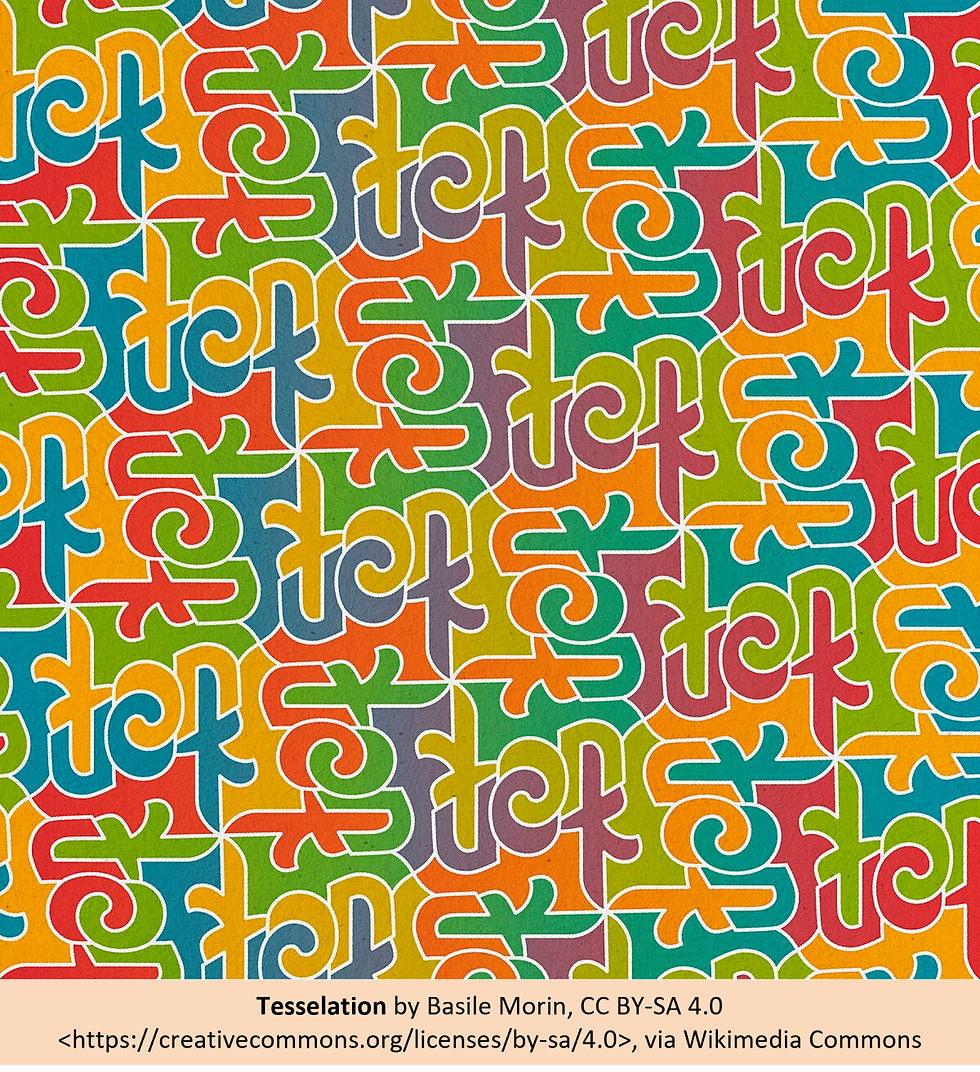Don't Delete the Expletives!
- Dr. Richard Lazenby

- Jul 21
- 8 min read
Updated: 1 day ago
Less pain, more strength: the benefits of saying ‘fuck’ out loud

Let’s face it, we’ve all been there, working on this or that activity and something goes awry. A toe getting in the way of a sledgehammer, a thumb catches a needle re-sewing that button, a head too high or a beam too low. And the first words we share with the world at that moment are, to be kind, in fact unkind. Call it swearing, or cussing (as in the United States), vulgarity, obscenity… so-called taboo words are ubiquitous across human languages.
Of course we don’t all swear alike. Use of taboo words varies across cultures, by sex and age, by social and religious norms, by habit, and by personality. Men swear more than women, for example. A 2024 study by Sulpizio and her colleagues looked at the use of taboo words in 17 countries around the globe: Germans swore on average almost 2x more often than the next highest group (Dutch), and significant differences were found even within languages: among English speakers, Australians swore 2x more frequently than Canadians or Britons, but about the same as Americans. Children begin using taboo words as early as 1-2 years of age, though not becoming contextually equivalent to adults until around age 12. Swearing and the use of taboo terminology also serves different functions: abuse (‘you’re a shithead”), group identity (derogatory labels such as the 'n-word’ or any number of other cultural references), for emphasis (this is fucking amazing!) and of course to show emotion, as noted at the outset.
So, why is swearing so common? It makes one wonder: what’s the purpose of swearing, what use does it serve? In fact, it appears there are many. Studies over the past decade or so have shown that swearing is associated with increased self-confidence and credibility, heightened humor, stronger social connections as well as improved memory and recall. But there are two areas in which swearing may incur other significant benefits: diminishing pain (both physical and social) and in boosting physical performance.
Regarding the latter, experimental studies have shown that swearing increased peak power by an average of 4.5% and grip strength by 8%. In a separate study, participants could maintain the chair push-up position 10% longer if swearing. These are not minor variances when one considers that there was only a 1.23% difference in the finishing times between 1st and 8th place in the men’s 100-meter sprint at the 2024 Summer Olympics held in France. Mind you, researchers note that the taboo nature of swearing would likely exclude approval for its use in such sporting events (though some athletes may mimic swearing by substituting grunting or some other plosive expression in performing their task – a number of tennis players and baseball pitchers are known to do so when hitting or throwing the ball).
What about pain and swearing? Since 2009, Richard Stephens from the School of Psychology, Keele University and his colleagues have been looking at the way swearing has a hypoalgesic effect [see footnote 1] on the physical sensation of pain – that is, does swearing modify our pain experience? Their early work suggested that the phenomenon is real – swearing increased pain threshold and tolerance and lowered perception. Swearers withstood more pain (threshold) for longer time frames (tolerance) and reported lower levels of pain (perception) than non-swearers in the same experimental protocol. But the mechanisms remained elusive. Were they physiological (such as activation of the sympathetic nervous system and the ‘fight or flight’ response, as reflected in heart rate elevation and skin conductance), psychological (eliciting an emotional response through humor or distraction), or perhaps a combination of both?
In 2020, Stephens and Robertson published a novel study to see if a common English swear word (fuck) was more able to moderate pain than two made up swear words (fouch and twizpipe) or a neutral word that would have no significant connection to pain experience [see footnote 2]. Ninety-two young healthy adults were asked to fully submerge their non-preferred hand in a basin of ice-water (3° to 5° C) for up to 3 minutes and repeat one of the four words using their normal voice every 3 seconds [see footnote 3]. Pain threshold (when pain is first felt) and pain tolerance (length of immersion) were recorded as seconds, along with heart rate. Participants were also asked whether repeating the word elicited an emotional response (excitement or anger), a humorous response (saying the word over and over was funny), or a distraction response (repetition made them think of something other than the pain). Turns out that, when compared to the neutral word repeating the word ‘fuck’ significantly increased pain threshold and pain tolerance, as well as higher ratings for humor, distraction and emotion. The made-up swear words fouch and twizpipe, while resulting in higher ratings for humor and emotion, had no impact on pain experience nor distraction. Interestingly, across all tests there was no elevation in heart rate, suggesting that activation of the sympathetic response was not the mechanism responsible for the hypoalgesic effect of swearing. However, Stephens and Robertson suggested that exposure to four immersions in a row may have had a blunting effect on sympathetic response, as earlier studies using only two immersions did show heart rate elevation.
So why would made-up ‘swear’ words not provide the same benefit in lessening pain experience than a real swear word? Stephens and Robertson suggest that the reason may lie in what is known as aversive classical conditioning. As said earlier, we learn to swear early in childhood, and in most circumstances in Western cultures swearing – especially by children – provokes a negative response, i.e., some form of reprimand from an authority figure (such as a parent). Hence the taboo aspect, and power, that is associated with swear words. We learn early on that they are not just bad but are really bad! The made-up swear words fouch and twizpipe, created because they have characteristics of swear words, are new and thus have no childhood aversive connotation.
But diminishing pain through swearing goes beyond the physical and into the realm of social pain. This is perhaps not surprising as physical pain and social pain are seen to be connected, as suggested by a theory known as pain overlap. Pain overlap theory argues that interventions lessening physical pain should also lesson social pain – and has been shown to work in studies of social pain experience where the intervention was medical marijuana and acetaminophen (both known to lower physical pain).
A paper published in 2017 by psychologists Michael Phillip and Laura Lombardo explored the effect of swearing on the social pain of ostracism. A total of 62 participants were asked to write a short autobiographical essay about a time when they felt either socially excluded or included. They were able to write from 2 to 6 minutes. Following this they were randomly assigned to utter either a swear word (shit or fuck) or a neutral word (selected to describe a chair – in this case, hard and flat). They did this for 2 minutes while holding their hand in a room temperature water bath. Now, this may sound a bit strange, but the purpose was to prepare them for a later test to gauge physical pain sensation using the cold pressor test described earlier. Participants were then assessed for 3 measures of psychological impact: a moods test, a needs satisfaction test, and a social pain test, the latter on a 100-point scale from ‘no social pain’ to ‘maximum social pain) in recalling their inclusion / exclusion experience. Lastly, they were given the cold pressor test, holding their hand in cold water until they felt pain while saying a made-up so-called nonsense word ‘dop’ at a steady pain. Why dop? The purpose here was to keep a participant from silently swearing which might mitigate their experience of physical pain in the test. They finished this last task by rating their pain experience from zero (no pain) to 100 (worst pain imaginable).
What did they find out? Well, those who wrote about exclusion had lower mood index (more sad), a lower needs satisfaction (less supported), and reported higher social pain than those who wrote about an inclusion experience. Probably not surprising. But what was the effect of swearing? In this study, swearing did not affect ‘mood’ nor ‘needs satisfaction’ score, but swearing did reduce the impact of social pain. For swearers in the excluded group, social pain was reduced by almost 16 points compared to non-swearers in that same group. And while swearing did reduce the experience of physical pain in the excluded group (and not at all in the included group) that reduction was not found to be significant.
This brings me to the final consideration on swearing and pain: dosage and habituation. Dosage refers to the intensity, the frequency, and the total quantity of an intervention – in this case, swearing! Across different studies only frequency varied; participants were instructed to utter the chosen swear word from a specified rate of 2 to 5 seconds apart or ‘at a steady pace’. Intensity was controlled by using a normal voice (not whispering nor shouting) and quantity by the set duration of the test. Regardless of frequency, swearing had a hypoalgesic effect on pain. Habituation – the reduced response to a stimulus by repeated exposure – is a different matter. Most commonly, people who swear less frequently in their daily lives tended to benefit from a greater hypoalgesic effect than those who swore more commonly. This would suggest that those who use of taboo language as a matter of everyday speech are going to hurt more when they bang their head, as the hypoalgesic result for them will be less effective. It should be noted that as of now this effect has not been examined in terms of swearing and performance.
Bottom line: the next time you stub your toe, hit your thumb with a hammer, or walk into a pole while texting, feel free to say your favorite go-to expletive out loud as many times as you want and, if asked to apologize you’ve got the science to justify your exclamation!
Footnote 1. A hypoalgesic effect is when an intervention diminishes a particular (negative) experience. The most common example would be taking acetaminophen to ease a headache.
Footnote 2. In this study the neutral word was chosen by each participant as one that they would personally use to describe a table.
Footnote 3. This test is called the cold pressor test and is used to look at cardiovascular reactivity and the autonomic nervous system response. Another phenomenon in which this test is used is to compare population differences in the physiological response known as Cold-Induced Vasodilation, which measures how quickly your body’s circulation reacts to cold-exposure by widening (dilating) blood vessels to rewarm your extremities.
Where to find the Science:
Sulpizio, S et al. (2024) Taboo language across the globe: A multi‑lab study. Behavior Research Methods 56:3794–3813 https://dx.doi.org/10.3758/s13428-024-02376-6
Stephens, R and Robertson, O (2020) Swearing as a response to pain: assessing hypoalgesic effects of novel “swear” words. Frontiers in Psychology 11:723. https://dx.doi.org/10.3389/fpsyg.2020.00723
Philipp, MC and Lombardo L (2017) Hurt feelings and four letter words: Swearing alleviates the pain of social distress. European Journal of Social Psychology 47: 517-523. https://dx.doi.org/19.1002/ejsp.2264
See also:
Hay, CM et al. (2024) F@#$ pain! A mini-review of the hypoalgesic effects of swearing. Frontiers in Psychology 15:1416041. https://dx.doi.org/10.3389/fpsyg.2024.1416041
Washmuth NB, Stephens R and Ballmann CG (2024) Effect of swearing on physical performance: a mini-review. Frontiers in Psychology 15:1445175. https://dx.doi.org/10.3389/fpsyg.2024.1445175





コメント